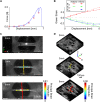Three-Dimensional Quantification of Collagen Microstructure During Tensile Mechanical Loading of Skin
- PMID: 33748088
- PMCID: PMC7966723
- DOI: 10.3389/fbioe.2021.642866
Three-Dimensional Quantification of Collagen Microstructure During Tensile Mechanical Loading of Skin
Abstract
Skin is a heterogeneous tissue that can undergo substantial structural and functional changes with age, disease, or following injury. Understanding how these changes impact the mechanical properties of skin requires three-dimensional (3D) quantification of the tissue microstructure and its kinematics. The goal of this study was to quantify these structure-function relationships via second harmonic generation (SHG) microscopy of mouse skin under tensile mechanical loading. Tissue deformation at the macro- and micro-scale was quantified, and a substantial decrease in tissue volume and a large Poisson's ratio was detected with stretch, indicating the skin differs substantially from the hyperelastic material models historically used to explain its behavior. Additionally, the relative amount of measured strain did not significantly change between length scales, suggesting that the collagen fiber network is uniformly distributing applied strains. Analysis of undeformed collagen fiber organization and volume fraction revealed a length scale dependency for both metrics. 3D analysis of SHG volumes also showed that collagen fiber alignment increased in the direction of stretch, but fiber volume fraction did not change. Interestingly, 3D fiber kinematics was found to have a non-affine relationship with tissue deformation, and an affine transformation of the micro-scale fiber network overestimates the amount of fiber realignment. This result, along with the other outcomes, highlights the importance of accurate, scale-matched 3D experimental measurements when developing multi-scale models of skin mechanical function.
Keywords: collagen; kinematics; microstructure; multiscale; second harmonic generation; skin; structure-function relationship.
Copyright © 2021 Woessner, Jones, Witt, Sander and Quinn.
Conflict of interest statement
The authors declare that the research was conducted in the absence of any commercial or financial relationships that could be construed as a potential conflict of interest.
Figures







Similar articles
-
Quantification of age-related changes in the structure and mechanical function of skin with multiscale imaging.Geroscience. 2024 Oct;46(5):4869-4882. doi: 10.1007/s11357-024-01199-9. Epub 2024 May 18. Geroscience. 2024. PMID: 38761286 Free PMC article.
-
Multiscale Computational Model Predicts Mouse Skin Kinematics Under Tensile Loading.J Biomech Eng. 2022 Apr 1;144(4):041008. doi: 10.1115/1.4052887. J Biomech Eng. 2022. PMID: 34729595 Free PMC article.
-
Morpho-mechanical mapping of human dura mater microstructure.Acta Biomater. 2023 Oct 15;170:86-96. doi: 10.1016/j.actbio.2023.08.024. Epub 2023 Aug 19. Acta Biomater. 2023. PMID: 37598794
-
A comprehensive study of layer-specific morphological changes in the microstructure of carotid arteries under uniaxial load.Acta Biomater. 2017 Jul 15;57:342-351. doi: 10.1016/j.actbio.2017.04.033. Epub 2017 May 9. Acta Biomater. 2017. PMID: 28499632
-
A review of techniques for visualising soft tissue microstructure deformation and quantifying strain Ex Vivo.J Microsc. 2018 Dec;272(3):165-179. doi: 10.1111/jmi.12701. Epub 2018 Apr 14. J Microsc. 2018. PMID: 29655273 Review.
Cited by
-
Fourier transform-based method for quantifying the three-dimensional orientation distribution of fibrous units.Sci Rep. 2024 Jan 23;14(1):1999. doi: 10.1038/s41598-024-51550-5. Sci Rep. 2024. PMID: 38263352 Free PMC article.
-
Impact of paraben on uterine collagen: An integrated and targeted Correlative approach using second harmonic generation microscopy, nanoindentation, and atomic force microscopy.J Mech Behav Biomed Mater. 2025 May;165:106926. doi: 10.1016/j.jmbbm.2025.106926. Epub 2025 Feb 1. J Mech Behav Biomed Mater. 2025. PMID: 39946870 Free PMC article.
-
Biophotonic tools for probing extracellular matrix mechanics.Matrix Biol Plus. 2021 Nov 18;12:100093. doi: 10.1016/j.mbplus.2021.100093. eCollection 2021 Dec. Matrix Biol Plus. 2021. PMID: 34934939 Free PMC article.
-
Quantification of age-related changes in the structure and mechanical function of skin with multiscale imaging.Geroscience. 2024 Oct;46(5):4869-4882. doi: 10.1007/s11357-024-01199-9. Epub 2024 May 18. Geroscience. 2024. PMID: 38761286 Free PMC article.
-
Mechanical Models of Collagen Networks for Understanding Changes in the Failure Properties of Aging Skin.J Biomech Eng. 2024 Jul 1;146(7):071002. doi: 10.1115/1.4064406. J Biomech Eng. 2024. PMID: 38183223 Free PMC article.
References
Grants and funding
LinkOut - more resources
Full Text Sources
Other Literature Sources

